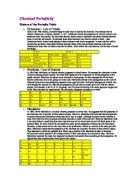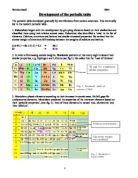When the properties of Gallium were found they matched approximately the properties of Mendeleev’ prediction (Fig1), this helped to reinforce Mendeleev’ periodic table, and subsequent elements were found which support his predictions of elements and their properties, and produced the modern periodic table.
Fig 1 (A)
Gallium
Gallium (Ga) is a metal which is in group III and period 4; it has an atomic number of 31 and a relative atomic mass of 69.7.
For a metal is has some unusual properties for example, it is denser when it’s a liquid, this properties is shared with water, and means that when solid gallium melts it decreases in volume, this is because gallium and water have a relatively more open structure when it’s a solid, so when it’s a liquid the molecules get closer together and loose the structure. Another properties which is unusual is that it has an extremely large temperature range for when it’s a liquid, solid gallium melts at ≈22.78oC (B), and boils at 2403oC (C), this makes it prefect for high temperature thermometers. Another unusual physical properties is that its only one of three elements which has a melting points near room temperature, this means that gallium will melt in the palm of your hand. The last unusual property is chemical, in that it dissolves in both acids and bases; this characteristic is shared with aluminium (fig2).
The appearance of Gallium, in its colour and feel would indicate that it’s a metal (Fig3), also its high boiling point also indicates that it’s a metal, however the fact that the melting point is so low would indicate that it’s a non metal.
Acid
Alkali
Fig 2 (D)
Fig3 (E)
Spectroscopy
Spectroscopy is method used by chemists to detect elements. It was discovered in 1860, and was used to discover new elements in the periodic table at the time. An electric arc, excites electrons within an atom, by this the arc gives the electrons energy, this energy, which is in packets, is adsorbed by the electrons in the atom, and the electrons move to a higher energy level within the atom. The jump in energy level which occurs is equal to energy gained by the electron. Once the electron is in a higher energy level, it falls back to its original position, in doing so it gives off energy; this energy is in the form of photons of light (sometimes, UV or IR light). The photons of light which are given off are visible. The frequency of the photon is equal to the jump the electron made, and the frequency of photon corresponds to a colour of light. Each element has different energy levels within it so each element will produce different colours of light. When the light given off by the electron is split by a prism, all the colours can be seen as lines and each element has a different set of lines, so elements can be identified (Fig4). This method relies on the knowledge of known atoms, if a new element is to be found the known compounds are tested and the contaminated compounds show new elements, so the spectrum which is produced by the uncontaminated compounds needs to be known for anomalies to be found. The structure of these elements is also crucial, as the knowledge of the energy levels will determine the energy given off. (f)(G)
Fig 4 (H)
UNILAC
The UNILAC accelerator is a machine which is designed to make new atoms. It employs a method of firing ions at a rotating disk. The elements of ions and the elements which the disk is made of determine which element is made, for example:
(I)
Ions of chromium were fired at a disk of bismuth and the result was an element with atomic number 107. The nuclei’ of the elements fuse, as the high speed ions overcome the repulsion of nuclei. However this method is only successful to an extent, the elements which are produced usually only last a fraction of a second and therefore will never have a practical use. The process of making the elements gets harder as the element’s atomic number increases, with an increasing atomic number the time taken to obtain an amount of the element, which is detectable, becomes longer. This technique also relies on the knowledge of known atoms, as for a specific element to be created the atom number of the elements which will be used to make it have to be known. The structure will determine how the nuclei fuse and how the final element will come out.
Chemistry in the last 200 Years
During the last 200 years chemists have discovered methods to detect elements and classify them in a logical and informative method, which shows patterns and allows chemists to predict the properties of unknown elements. Chemists have also created methods to create new elements which are not found naturally, these elements are critical in the need for information about chemistry.
Bibliography
- Article 1, Pg5, Table 1
- Article 1, Pg6, Physical Properties
- Article 1, Pg6, Physical Properties
- Article 1, Pg6, Some Chemical Properties
- http://www.bbs-winsen.de/GoBlack/ETechnik/elektro/grundlagen/elemente/Gallium.htm
- http://csep10.phys.utk.edu/astr162/lect/light/absorption.html
- http://csep10.phys.utk.edu/astr162/lect/light/zeeman-split.html
- http://csep10.phys.utk.edu/astr162/lect/light/absorption.html
- Article 2, Pg9, Success Story







